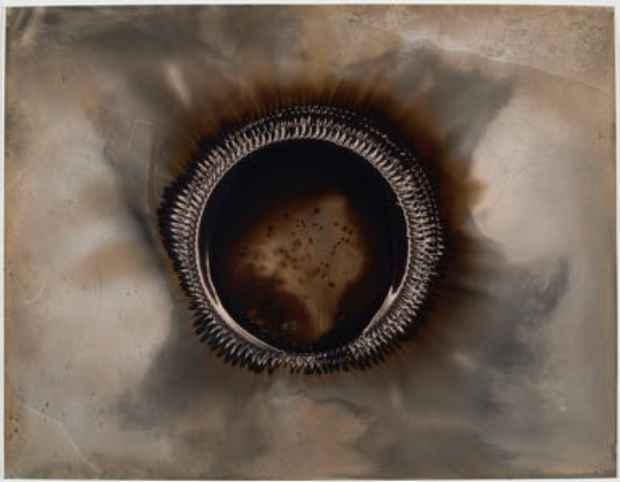“Tremolo” Exhibition
Rick Wester Fine Art

[Image: Christopher Colville "Ouroboros 3" (2016)]
This event has ended.
Curated by Carolanna Parlato
Rick Wester Fine Art presents a group exhibition, Tremolo, featuring works by ten artists employing widely varied mediums, including painting, photography, video and neon. Curated by the New York based painter Carolanna Parlato, the show’s concept centers on the tremulous effects found in each artist’s work. The term tremolo refers to the vibrating effect produced on musical instruments when there is a rapid alternation of one or two musical tones. It can also refer to a nervous or involuntary quiver or trill in the human voice. Through their visual experiments with vibration and movement, open interval and colored note, each artist has constructed hybrid forms that respond to the technological world we live in, echoing today’s anxiety-ridden zeitgeist. The artworks chosen stem from divergent impulses and methods, welcoming an open-ended process of looking and relating.
Christopher Colville’s latest series, Ouroboros, takes its title from an ancient symbol shared in many cultures. The depiction of the snake eating its own tail alludes to the infinite cycle of life, death and regeneration. Colville places a collapsing band saw blade on gelatin silver paper with a measure of gunpowder which, when ignited, creates an image of the serrated teeth’s shadows. The heat transforms the silver, creating an eerie aura of an apocalyptic event, either the birth of creation or the end of time.
Elisabeth Condon’s use of translucent color, Chinese ink, mounds of glitter and iridescent glazes combines gestural deliberation with spontaneous pours. Patterns inch toward recognizable structures but refuse to cohere, retaining a permeable and formless suggestiveness.
In Lynn Dunham’s Stereo Eclipse series, atmospheric halos are juxtaposed with hard edge minimalism to create pulsing illuminations from an unknown source. The composition of upper and lower focal points references the woofer and tweeter components of a speaker, alluding to an imagined vibrato.
Norma Markley is drawn to works of sexualized literature by authors such as Nabokov and Charles Bukowski. Integrating the language and imagery of these texts,
Markley’s neon works reflect a bygone America and have been described as “symbols of throwaway culture.” Titled with a question “What do they call you in bed?”, the answer is the neon piece, Heeeheeeheeehehehehe…, a word that is audible in silence. You read as you hear as you look.
Tom McGlynn’s paintings set in motion a subtle shift of tectonic form. Carefully augmented by color combination, the works feel simultaneously familiar and fleeting. These selections from the artist’s Decal series take generic logotypes into vibratory realms of transcendental contemplation.
Kristin McIver’s Data Portraits disrupt the streams of big data accumulating behind social media networks. A commentary on celebrity in the Age of the Internet, McIver re-situates face recognition data from within the computer network into hand-painted visualizations of her subjects. Appropriating the scale and color palette of Andy Warhol’s reflect the technological advances of contemporary society.
The threads that run through Maureen McQuillan’s work are seemingly opposites: surface and depth, gesture and geometry, system and disorder. Through repetition, the motif becomes something more complex, and color reverberates; creating a sense of space that is both real and illusory.
Ray Rapp’s video works focus on the repetitive movement associated with a physical activity. In Golfer, Rapp goes beyond the use of the camera as the sole support and turns the video selections into animations projected onto glass. The scenes become at once introspective and direct, giving motion a timeless and ethereal effect.
Alyse Rosner’s work combines rhythmic layers of line, long unfurling strands, fine staccato marks and vibrant transparent wash over graphite rubbings. Speed and movement are modulated as dashes vibrate over a flowing channel of color, and opaque turquoise bars both disrupt and lend structure.
Aaron Rothman’s exploration of the photographic picture-making process leads him to extraordinary exploitation of the image plane. In the series Cosmos, he points his camera towards the Arizona desert night sky, pushing the limits of the equipment to record infinity. The resulting images become pointillist canvases that define the outer reaches of human and camera vision.
Media
Schedule
from May 11, 2017 to July 28, 2017
Opening Reception on 2017-05-11 from 18:00 to 20:00